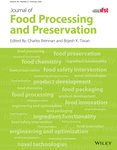Nutrient composition, free radical scavenging activities and polyphenol contents of seabuckthorn (Hippophae tibetana) Western Himalayas, India
Funding information
Partial financial support received from International Center for Integrated Mountain Development (ICIMOD) under Kailash Sacred Landscape Conservation and Development Initiative (KSLCDI) and Department of Science and Technology, India under National Mission for Sustaining the Himalayan Ecosystem (NMSHE) “Forest Resources and Plant Biodiversity” Task Force-3 is gratefully acknowledged.
[Correction added on January 13, 2022, after first online publication: Figure 2 and Figure 3 have been changed.]
Abstract
Hippophae tibetana is valuable wild edible berry, which is utilized as a supplement of food, traditional-folk medicine system by rural populace of the Johar valley, Pithoragarh district India. The study focused on quantitating the nutrient composition, polyphenols, and free radical scavenging activities of the specie (in different solvent extracts). Results represented a various concentration range of polyphenolics and antioxidants among studied solvents, and fresh berries exhibited good sources of polyphenols (phenolics 1.64; tannins 5.87; proanthcyanidins 1.47; flavonoids 5.74; flavonols 0.62 mg/g), antioxidants, and free radical scavenging activities (FRAP 9.55; DPPH 1.35; NO·1.14; ABTS 4.10; OH· 0.69 mM AAE/100 g), nutrients (carbohydrates 2.05; proteins 0.67; methionine 0.73; proline 1.03; sodium 0.37; potassium 3.0.25 mg/g) and vitamins (vitamin C 1.03; vitamin E 0.87; Vitamin A 0.59 mg/g), respectively, followed by dry berries and pomace. Outcomes of the study revealed that acetone and methanol are good for extraction for harnessing maximum potential from the species.
Practical applications
- H. tibetana has emerged as a potential source of nutritional and bioactive constituents, and moderate polarity solvents (acetone and methanol) are best for extraction and acetone should be prioritized for commercial utilization.
- In the present scenario, several communities worldwide are focused to consume natural antioxidant compounds for improving their health, immunity, and reducing the deficiency of malnutrition. The fresh berries of H. tibetana and their processed foodstuffs can be considered an option for fulfilling the basic requirements of nutrients in the future and will be helpful for reducing deficiency of malnutrition in the Himalayan populace.
- Present study highlighted that berries of H. tibetana are rich sources of various nutrients, polyphenols, and antioxidant contents and for harnessing maximum potential from the species their mass scale cultivation is required. Therefore, sensitization workshops and capacity-building programs (for skill development) should be organized in the higher Himalayas for the promotion of cultivation practices/large-scale plantation of H. tibetana in their suitable habitat (cold desert) through participatory approaches, also required to strengthen the sub help groups (SHG). This approach will fulfill the major issues of biodiversity conservation, wasteland reclamation, and generate employment opportunities for the local communities of Himalayas.
CONFLICT OF INTEREST
The authors declare that they have no conflict of interest.
Open Research
DATA AVAILABILITY STATEMENT
The data set that support the findings of this study are available on request from the corresponding author. The data are not publicly available due to privacy or ethical restriction. Therefore ‘Research data are not shared.’




